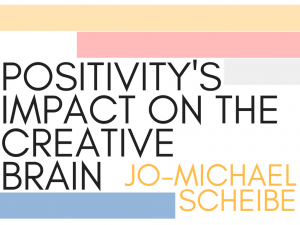
The creatively-minded are considered to be free-spirits or daydreamers, which purportedly sets them apart from pencil pushers and those interested in the sciences. However, did you know that there's scientific evidence suggesting that anyone can be creative? More than that, did you know that ambiance and mental outlook are fundamental provocations when it comes to creative productivity?
There are many components to what kind of environment and mental preparation stimulates creativity, and it starts with a positive setting.
“Rigorous scientific evidence has shown that focusing on acts of gratitude will increase performance in a multitude of ways,” according to a recently published Forbes article.
Emotion is related to the kind of creative work produced. Think of any pop artist. The chances are that they are relatively upbeat, forward-looking people. Compare this to a mid-90’s grunge band. This genre was notoriously dominated by men and women who constantly sulked. The kind of emotion hidden behind the music produced varied results.
This can be applied to any person’s work. If your boss focuses only on things you need to improve, you may feel as though you’re unable to produce any good work, which could lower your motivation. On the other hand, a work environment that is positive and uplifting might empower employees to try their hardest, since they know they have an opportunity to be recognized. Positive reinforcement is psychologically shown to produce good results, so surrounding yourself with empowering people may influence your mindset tremendously.
So how exactly does emotion play into creativity?
“Sadness in art is perplexing. People love performing and listening to sad music, but, try to avoid sadness in other areas of their lives,” says Malinda McPherson in The Atlantic.
It is possible that creating sad art allows us to embrace the feelings and struggles that we may not otherwise feel comfortable sharing. It gives people a way to share their experiences with one another and receive support. The creation of this type of art, in turn, is therapeutic to both the creator and the audience.
But how does this relate to people who aren’t artists? Every person is tasked with a multitude of creative decisions in their lives, from deciding how to decorate your home to create a playlist for your next party. However, many people can experience a lower level of creativity, due to stress and boredom. According to Forbes, the best way to stimulate a creative mind is to reduce stress and eliminate boredom. Completing mundane tasks that are second-nature gets old quickly, so varying your workload can produce better, more creative results.
Still, the research on the correlation between creativity and brain stimulation is still ongoing. “There are so many deep and critical questions when it comes to the neuroscience of art,” Charles Limb says. “It may take a while before we can unify the knowledge across disciplines.” Despite the lack of research on this subject, everyone can heed this advice: to produce creative work; you have to get in the right mindset.
 The creatively-minded are considered to be free-spirits or daydreamers, which purportedly sets them apart from pencil pushers and those interested in the sciences. However, did you know that there's scientific evidence suggesting that anyone can be creative? More than that, did you know that ambiance and mental outlook are fundamental provocations when it comes to creative productivity?
There are many components to what kind of environment and mental preparation stimulates creativity, and it starts with a positive setting.
“Rigorous scientific evidence has shown that focusing on acts of gratitude will increase performance in a multitude of ways,” according to a recently published Forbes article.
Emotion is related to the kind of creative work produced. Think of any pop artist. The chances are that they are relatively upbeat, forward-looking people. Compare this to a mid-90’s grunge band. This genre was notoriously dominated by men and women who constantly sulked. The kind of emotion hidden behind the music produced varied results.
This can be applied to any person’s work. If your boss focuses only on things you need to improve, you may feel as though you’re unable to produce any good work, which could lower your motivation. On the other hand, a work environment that is positive and uplifting might empower employees to try their hardest, since they know they have an opportunity to be recognized. Positive reinforcement is psychologically shown to produce good results, so surrounding yourself with empowering people may influence your mindset tremendously.
The creatively-minded are considered to be free-spirits or daydreamers, which purportedly sets them apart from pencil pushers and those interested in the sciences. However, did you know that there's scientific evidence suggesting that anyone can be creative? More than that, did you know that ambiance and mental outlook are fundamental provocations when it comes to creative productivity?
There are many components to what kind of environment and mental preparation stimulates creativity, and it starts with a positive setting.
“Rigorous scientific evidence has shown that focusing on acts of gratitude will increase performance in a multitude of ways,” according to a recently published Forbes article.
Emotion is related to the kind of creative work produced. Think of any pop artist. The chances are that they are relatively upbeat, forward-looking people. Compare this to a mid-90’s grunge band. This genre was notoriously dominated by men and women who constantly sulked. The kind of emotion hidden behind the music produced varied results.
This can be applied to any person’s work. If your boss focuses only on things you need to improve, you may feel as though you’re unable to produce any good work, which could lower your motivation. On the other hand, a work environment that is positive and uplifting might empower employees to try their hardest, since they know they have an opportunity to be recognized. Positive reinforcement is psychologically shown to produce good results, so surrounding yourself with empowering people may influence your mindset tremendously.
 The creatively-minded are considered to be free-spirits or daydreamers, which purportedly sets them apart from pencil pushers and those interested in the sciences. However, did you know that there's scientific evidence suggesting that anyone can be creative? More than that, did you know that ambiance and mental outlook are fundamental provocations when it comes to creative productivity?
There are many components to what kind of environment and mental preparation stimulates creativity, and it starts with a positive setting.
“Rigorous scientific evidence has shown that focusing on acts of gratitude will increase performance in a multitude of ways,” according to a recently published Forbes article.
Emotion is related to the kind of creative work produced. Think of any pop artist. The chances are that they are relatively upbeat, forward-looking people. Compare this to a mid-90’s grunge band. This genre was notoriously dominated by men and women who constantly sulked. The kind of emotion hidden behind the music produced varied results.
This can be applied to any person’s work. If your boss focuses only on things you need to improve, you may feel as though you’re unable to produce any good work, which could lower your motivation. On the other hand, a work environment that is positive and uplifting might empower employees to try their hardest, since they know they have an opportunity to be recognized. Positive reinforcement is psychologically shown to produce good results, so surrounding yourself with empowering people may influence your mindset tremendously.
The creatively-minded are considered to be free-spirits or daydreamers, which purportedly sets them apart from pencil pushers and those interested in the sciences. However, did you know that there's scientific evidence suggesting that anyone can be creative? More than that, did you know that ambiance and mental outlook are fundamental provocations when it comes to creative productivity?
There are many components to what kind of environment and mental preparation stimulates creativity, and it starts with a positive setting.
“Rigorous scientific evidence has shown that focusing on acts of gratitude will increase performance in a multitude of ways,” according to a recently published Forbes article.
Emotion is related to the kind of creative work produced. Think of any pop artist. The chances are that they are relatively upbeat, forward-looking people. Compare this to a mid-90’s grunge band. This genre was notoriously dominated by men and women who constantly sulked. The kind of emotion hidden behind the music produced varied results.
This can be applied to any person’s work. If your boss focuses only on things you need to improve, you may feel as though you’re unable to produce any good work, which could lower your motivation. On the other hand, a work environment that is positive and uplifting might empower employees to try their hardest, since they know they have an opportunity to be recognized. Positive reinforcement is psychologically shown to produce good results, so surrounding yourself with empowering people may influence your mindset tremendously.
